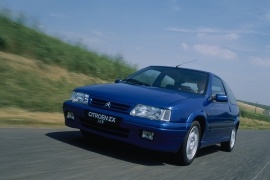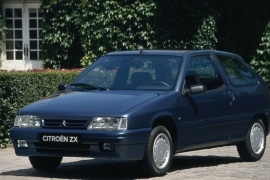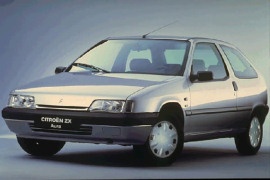CITROEN ZX 3 Doors Models/Series Timeline, Specifications & Photos
First production year: 1992
Engines: Gasoline, Diesel
Body style: Hatchback
After six years on the market, Citroen made a final refresh for the ZX range, and, besides the five-door hatchback and the station wagon, the three-door version was also upgraded.
Even though it was not the most thought-after version from the ZX's lineup, the three-door version was still appealing to the younger generation. It tried to be a French alternative to other compact three-door hatchbacks on the market produced in Germany or Italy.
Citroen's design department didn't sweat too much on redesigning this final, upgraded version of the car. It kept the same front fascia, introduced in 1994, but it painted the hidden door handles and mirrors. Yet, they didn't consider darkening the B-pillar to make the car look like a proper coupe. But the addition of alloy wheels and a roof spoiler for the sportiest version were a few good reasons to take this French compact hatchback.
The interior was fitted with new amenities on more trim levels. Things like air-conditioning, tape-player, and power windows were no longer used only for the most expensive versions of the three-door ZX. Moreover, the 16v version also got bucket seats with high-bolstered areas.
Under the hood, Citroen installed a wide choice of engines ranging between 67 hp and 161 hp (68 PS and 163 PS) paired with five-speed manuals.
After four years on the market, Citroen refreshed the entire ZX lineup with major improvements in both safety and engine departments.
With a choice of three bodyworks, 3- and 5-door hatchbacks, and a station wagon, the ZX competed mainly with the Volkswagen Golf III and the Opel/Vauxhall Astra. It just lacked the sedan and the convertible.
Citroen was already under full Peugeot ownership when it introduced the model, and it couldn't do things the way it used to. Still, the design resembled the former Axel in terms of proportions, especially for the three-door hatchback. Its squared headlights and the grille between them made a clear connection with that model, even though the ZX was bigger. In addition, the carmaker chose an unusual solution for the door handle, which was vertically flush-mounted. At the back windows, a pop-out opening system brought more fresh air into the cabin.
Inside, there were a few improvements, such as single or dual side airbags. Most versions benefited from the power steering. Moreover, it was available with power windows. Considering that it was not a premium vehicle, it was considered an important upgrade for the French brand, which tried to compete with the German carmakers. However, despite all its efforts and good product quality, the ZX didn't get the same sales results as its European competitors. Last but not least, it had to fight against its Peugeot sibling, the 306, which was built on the same platform.
Under the hood, the revised version was offered with a choice of gasoline and diesel engines paired with a five-speed manual gearbox.
After a four-year gap between the models, Citroen introduced a replacement for the GS range in 1990: the ZX.
Like most carmakers, Citroen didn't reveal all its plans, and while it started with the five-door hatchback version in 1990, it waited another year to introduce the three-door version. Later on, in 1993, it added the station wagon. For some reason, the three-door was more important. Citroen built a rally-raid version on its base and won the Paris-Dakar race in 1990. Then, the customers started to ask, "where is the three-door version?".
With a styling signed by Bertone, the ZX looked special compared to other hatchbacks from the market. Its angular headlights resembled those installed on the BX lineup, and there was no grille between them. Still, the carmaker needed to cool the engine, placed a small gap between the hood and the front bumper, and added a grille on the apron. A black stripe protected the car's front and sides from minor scratches. The B-pillar was probably its most noticeable design signature, with a sloped lower line at its bottom. Behind it, a pop-out rear side window helped to ventilate the interior.
Inside, Citroen installed low-mounted front seats with almost no bolstering for the base models and sporty ones for the 16V version, its full-spec model. The squared-looking dashboard featured a raised, rectangular instrument cluster that sported side-mounted buttons. It was a reminiscence from the Citroen Visa. At least, they installed a turn-signal stack.
Under the hood, the carmaker offered the 3-door ZX with a choice of six engines, both gasoline, and diesel. A turbo-diesel was also on the list and provided decent performances for those times and excellent fuel efficiency.


